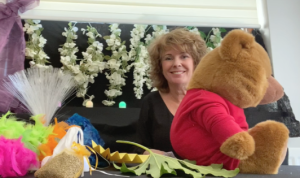The Story Massage Programme is a fun and effective way of teaching curriculum topics at St Giles School in Surrey. At the heart of the development of the programme is a dedicated team, working alongside Lynne Castle (pictured below), who has been a Higher Level Teaching Assistant at the school for over 20 years. “The benefits of the programme are just amazing,” says Lynne, “We have had many really magical and unexpected moments of interaction and communication. It is an important part of the the different pathways that are central to the curriculum.”
Interaction and Communication
St Giles School caters for children with complex physical difficulties, medical needs, speech and language difficulties and a range of associated learning difficulties aged 4 – 16. There is also a Further Education unit for young people with profound and multiple learning difficulties aged 16-19. “The students and staff all enjoy our Story Massage sessions,” says Lynne, “It’s wonderful to see how everyone relaxes and then we all feel so calm at the end. There is a noticeable change in behaviours. We might get rewarded with a smile or a squeeze of the hand from a student, and moments like this mean so much.”
Curriculum Topics
Lynne links the massage stories to curriculum topics which have included: The Great Outdoors and The Victorians (see below). She uses props to set the scene and then records a video demonstration of the massage story on the popular St Giles teddy bear. Lynne makes this into a powerpoint presentation with soft music playing in the background. “A presentation on an iPad means that everyone in the class can follow along together,” says Lynne, “It is a whole class experience. There is a sense of being together in a fully inclusive and supportive atmosphere. We usually have a maximum of 8 in a class with adults sharing the massage with the students. A couple of students might choose to massage an adult – it all depends on how they are a feeling on the day.”
Relaxation and Repetition
Curriculum-based Story Massage sessions are held weekly in different classes. They always begin with mindful breathing to help everyone relax and be ‘in the moment’. Lights are turned off, permission is sought and then staff follow-along with the topic-related video demonstration. “We take it very slowly and watch for verbal and non-verbal feedback so we can adjust strokes for maximum benefit to the individual student,” says Lynne, “We repeat the same massage story during the term as this helps the students get used to the rhythm and the words. Repetition is so important for learning.”
Creativity and Fun
Lynne is also very creative in using sensory props and began introducing everyday items as massage ‘tools’ during lockdown to create the sensation of the strokes without using hands. This was such a success with students that she continues to use these items on occasions to vary the lessons. For example, she might use wooden spoons to create the sensation of The Circle and The Fan strokes, and paintbrushes for The Wave stroke. “I love being creative,” says Lynne, “And the Story Massage Programme offers wonderful flexibility within the ten strokes.”
More about the Story Massage Programme
The Story Massage Programme combines the benefits of positive, respectful touch with the creativity and engagement of storytelling. Ten basic massage strokes are the foundation of the programme. These strokes have a simple name, such as The Circle or The Sprinkle, and an easy to recognise symbol making it accessible for all. It is a fully inclusive activity, no clothing is removed and no oil is used. Stories can be taken from our Story Massage book, adapted from favourite stories or songs or you can create your own massage stories.
Would you like to train in the Story Massage Programme?
Are you inspired by Lynn’s work within the pre-formal curriculum at St Giles School? Do you want to find out more? All the information is here: Online Training Course.
You will learn how to share the ten Story Massage strokes, adapt familiar stories and even create some sensory stories of your own. Ideal for well-being coaches, therapists, teachers, SEN staff, support staff, Early Years practitioners, those working with people with additional needs, everyone with an interest in sharing positive touch activities with adults or children.





